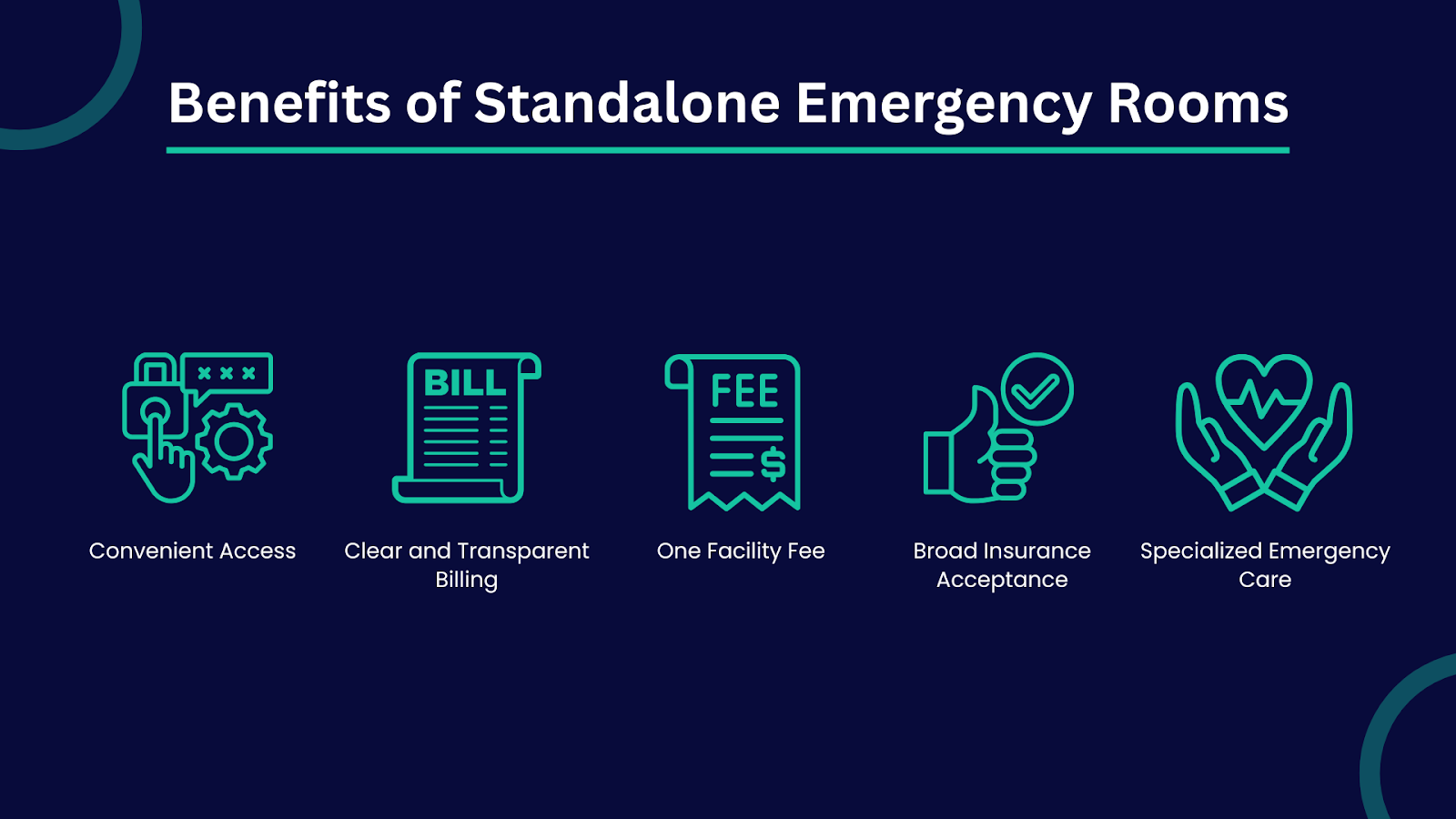An emergency department (ED) is the front line of any hospital, providing 24/7 critical care to patients in urgent need. It’s often the busiest area in any hospital or clinic. According to the National Hospital Ambulatory Medical Care Survey, there were 47 emergency department (ED) visits per 100 people in 2022, clearly indicating the crucial role of emergency medical services.
The ER is a vital lifeline in critical moments, delivering immediate and essential care. This blog explores emergency room billing. How it works, what it covers, common myths, significant challenges, and practical solutions.
What Is Emergency Room Billing?
Emergency room billing is how you can charge and claim payments for patient care in the ER. Usually, these bills include facility fees, which help cover the costs of running the ER and fees for the medical treatment that patients receive from doctors and nurses. Plus, any extra services, such as lab tests, X-rays, or medicines, are all listed separately on the bill.
Handling emergency room billing is a real challenge. It’s complicated and demanding to get right. It’s often much easier and more sensible to seek specialized help from reliable offshore partners.
From ER to Insurance: How Your Medical Bill Takes Shape?
Have you ever considered the intricate journey a medical bill takes after an emergency room visit? For healthcare enterprises, it’s far more than numbers on a statement, it’s a multi-step process involving meticulous documentation, accurate medical coding, insurance verification, and transparent patient communication. This guide walks through each phase, highlighting how ER encounters are transformed into finalized bills within revenue cycle management systems.
Step-by-Step Breakdown of Emergency Room Billing
The ER bill typically goes through six basic steps, which are as follows:
1. Patient and Provider Information Collection
The billing process begins once a patient enters your emergency room. Your medical team gathers all the essential info, like who the patient is, what insurance they have, and their medical background. The doctor then writes down what’s wrong, how they’re treated, and all the care they receive during their visit.
2. Medical Coding and Record Preparation
Professional medical coders translate the documented care into standardized codes (e.g., CPT Codes 99281-99285). These codes represent the treatments given and are essential for correct ER billing. The coded information is then organized and added to the patient’s formal medical record, whether it’s kept digitally or on paper.
| CPT Code | Description |
| 99281 | Minor presenting problem. |
| 99282 | Expanded problem-focused history and examination. |
| 99283 | Moderate severity problem. |
| 99284 | Moderate to High severity problem (Level 4). |
| 99285 | High severity problem. |
3. Claim Submission to Insurance
After the medical services are coded, the claim is sent to the patient’s insurance company. The insurance company checks the claim to ensure the services are covered by the patient’s policy. If everything looks good, they pay you (the healthcare provider). They also determine how much the patient owes, such as any deductibles or copays.
4. Explanation of Benefits (EOB) Sent to Patient
Once the insurance company has reviewed the claim, it’ll send the patient an Explanation of Benefits (EOB). This document breaks down the bill, showing how much the insurer paid, how much the patient owes, and why certain things might not have been covered.
5. Patient Billing and Payment Responsibility
After that, you will send the patient a bill for whatever portion of the cost the insurance didn’t cover. This bill will explain how and when to pay, and it will be the patient’s job to take care of the remaining balance.
6. Follow-up and Payment Support
If a patient has trouble paying the whole amount at once, they can ask about setting up a payment plan with you or see if they qualify for financial help. And if a claim is denied, the patient can always ask the insurance company to take another look by filing an appeal.
Clarifying the ER billing process helps demystify emergency room charges for patients. With a clear understanding of how these bills are structured, it’s equally important to highlight the true value of emergency care, starting with the critical benefits these services deliver.
Emergency Room Coverage: Who’s Eligible and What’s Included?
Emergency room services are a standard benefit included in most health insurance plans. Patients of any age, gender, or background can get ER care during medical emergencies that require prompt medical attention.
Since emergencies can happen unexpectedly, insurers usually cover a variety of services such as ER visits, physician fees, diagnostic tests, procedures, and urgent treatments. According to the Affordable Care Act (ACA), everyone has the right to access affordable, high-quality healthcare services and coverage.
Now that we’ve discussed who’s eligible and what’s included in ER coverage. Let us see the difference between emergency rooms and urgent care:
Emergency Rooms Vs Urgent Care?
As a hospital administrator or billing manager, you know that how you bill patients, especially those coming through Emergency Rooms (ER) or Urgent Care, can impact not just your revenue stream, but also patient satisfaction and insurance reimbursements.
Emergency Room Billing
When a patient enters your ER, you’re billing for far more than treatment. You’re accounting for critical infrastructure: 24/7 physician availability, specialized equipment, high-acuity staffing, and triage systems. The CPT codes reflect this complexity and urgency, resulting in higher reimbursement rates, but also more scrutiny from insurers. It’s essential you ensure coding accuracy to reduce claim denials and delays.
Urgent Care Billing
If you’re running an Urgent Care facility, the billing model shifts. Patients expect transparent, lower-cost services, and insurers often reimburse at lower, fixed rates. Here, your goal is efficiency, clear upfront pricing, rapid service, and improved coding that aligns with lower-acuity care. It’s about volume and speed, not complexity.
By optimizing how you manage billing across both settings, you’re not only staying compliant but you’re enhancing profitability and delivering care that fits both patient needs and payer expectations.
Now that you see the difference, it’s time to clarify some common misconceptions about emergency room services.
Common Misconceptions About Emergency Room Services
There are quite a few myths about emergency room services, and they can be quite bewildering when trying to figure out what’s covered. Let’s clear up some of these misunderstandings and separate fact from fiction.
Myth 1: ER Coverage Applies Only to Life-Threatening Cases
Fact: Emergency coverage doesn’t just apply to life-threatening situations. It also extends to unexpected injuries, intense pain, or illnesses that require immediate care.
Myth 2: Pre-Authorization Is Always Needed
Fact: In real emergencies, a patient won’t have time to get pre-approvals. Luckily, most insurance plans skip this requirement for emergency room visits.
Myth 3: Coverage Depends on Hospital Network
Fact: Regardless of whether the hospital is within your network, emergency services are always prioritized, ensuring that immediate assistance is available during critical situations. This approach guarantees swift and efficient care when it matters most.
Also Read: Medical Billing Guide for Out-of-Network Services
Now that we’ve debunked some of those widespread misconceptions about emergency room coverage, let’s explore how standalone emergency rooms are shaking things up, particularly when it comes to making the billing process more straightforward.
Standalone Emergency Rooms: Smoothing the Billing Process
Standalone emergency rooms operate independently from hospitals and are designed to provide fast, high-quality emergency care. These facilities ensure quick access to treatment while simplifying many challenges patients often face in traditional ER settings.
Benefits of Standalone Emergency Rooms (e.g., Advance ER)

- Convenient Access: Places like Advance ER are smartly positioned right in the heart of neighborhoods, so people can get emergency help quickly without having to travel far, especially when time is of the essence.
- Clear and Transparent Billing: Billing at standalone ERs is simple and clear. Patients get straightforward bills, which makes understanding the costs of the services they receive a breeze.
- One Facility Fee: Instead of hospitals, which bill separately for each department, standalone ERs typically use a single facility fee. This type of billing makes things simple and helps patients avoid unexpected charges.
- Broad Insurance Acceptance: Most standalone emergency rooms welcome a wide range of insurance plans, making it easier for patients to use their coverage without the stress of wondering if the facility is part of their network.
- Specialized Emergency Care: Staffed by highly trained personnel and equipped with state-of-the-art technology, freestanding emergency rooms are entirely equipped to address a broad spectrum of pressing medical situations effectively and compassionately.
Also Read: Outsourcing Revenue Cycle Management: Is It Right for Your Healthcare Growth?
Standalone emergency rooms have definitely improved the ER billing process, but there are still some hurdles to overcome. We’ll look at the typical billing problems these emergency rooms encounter and some realistic ways to solve them, including issues with insurance and paperwork backups.
Emergency Room Billing Challenges & Solutions: Tips for Patients
Despite the improvements, billing in emergency settings still comes with its share of challenges:
| Challenge | Description | Solution Tips |
| Insurance Network Limitations | Treating out-of-network patients often results in partial reimbursements, leaving patients with high out-of-pocket costs. | Stay informed and compliant with the No Surprises Act. Educate registration teams to highlight in-network options when feasible and verify benefits early. |
| Surprise Billing | When ED physicians or specialists bill separately from the hospital, patients may receive unexpected charges. | Standardize billing practices across departments. Where possible, bundle services under one bill to avoid discrepancies. Proactively communicate billing expectations during discharge. |
| Delayed or Incomplete Documentation | In the high-pressure ER environment, missing or inaccurate documentation can delay reimbursements or trigger denials. | Leverage EHR systems for real-time updates, and ensure clinical staff receive regular training on accurate coding and documentation protocols. |
| Lack of Cost Transparency | Without upfront estimates, patients are often shocked by post-visit charges, which can affect satisfaction and payment rates. | Implement tools that provide preliminary treatment cost estimates, even in emergency scenarios. Equip billing teams to explain charges and financial assistance options during or shortly after care. |
Tackling these ER billing challenges requires more than awareness. It requires expertise, efficiency, and a deep understanding of healthcare revenue cycles. That’s where specialized partners step in. Let’s take a closer look at how ProMantra supports emergency departments in navigating complex billing hurdles with precision and care.
Why Select Emergency Room Billing with ProMantra?
For healthcare providers, the ever-changing medical coding and insurance billing landscape can be daunting. ProMantra offers end-to-end revenue cycle management solutions curated to your emergency room billing needs.
At ProMantra, we specialize in accurate medical coding, insurance claim processing, and compliance-driven ER billing services. Our team of 350+ billing experts specializes in accurate coding, insurance claim processing, and compliance-driven workflows. We’re well-versed in ER-specific CPT codes like 99284, ensuring precise claims align with Medicare and major payer requirements. From verifying insurance eligibility and assigning accurate ICD-10-CM and CPT-4 codes to tracking claim statuses in real time, we handle it all.
Our tech-powered approach reduces errors and payment delays and lifts the administrative burden, so your focus remains on patient care. Plus, with HIPAA-compliant processes and actionable reporting, you gain complete visibility and control over your revenue cycle. By outsourcing your emergency room billing to ProMantra, you gain a trusted ally who allows you to focus more on patient care and less on paperwork. Let us simplify the complex so you can deliver healthcare with confidence. Contact Now.
FAQS
ER billing is the process of charging for services received during a visit to the emergency room. This includes facility fees, physician services, tests, and any treatments provided.
ER billing can be relatively high due to the need for 24/7 operations, specialized staff, diagnostic equipment, and the urgency of care, which often involves multiple services during a single visit.
Most insurance plans cover ER billing, but the extent of coverage can vary. It’s essential to check for in-network providers and understand your deductibles and copays.
A facility fee is like an entry fee for using the emergency room. It helps cover the costs of things like the equipment, the staff, and the general running of the place. This is different from the fees charged by the doctors themselves.
To save some money on your ER bills, double-check that your insurance will cover them, ask for a detailed breakdown of all the charges, and look closely for any mistakes. It’s also worth trying to negotiate the price or see if you qualify for any financial aid.




